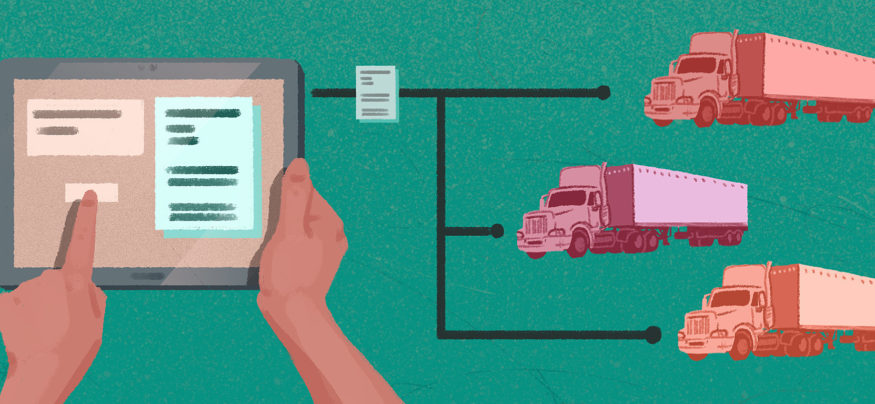The trucking industry is a major contributor to the U.S. economy, and ensuring the safety and reliability of this industry is a complex job. However, advances in trucking technology are making it easier for operators, drivers and inspectors to ensure that all trucks on the road are meeting the regulations developed by the Federal Motor Carrier Safety Administration (FMCSA).
Three major areas of regulation that are currently being streamlined by advances in trucking technology are licensing, maintenance and inspections, and weight limits, which have all been traditionally validated using paper-based methods. In addition to reducing risk and adding value to the enterprise, using new technology in the transportation pipeline also enhances customer service by allowing all parties involved in the logistics pipeline to maintain visibility into the delivery status, ensure asset accountability and set expectations for normal and abnormal operations.
Licensing
Driving a Commercial Motor Vehicle (CMV) is a tremendous responsibility, and driving in hazardous conditions across varied terrain requires a higher level of skill, planning and professionalism than is required to drive a car. Per the FMCSA, candidates for a CMV license must pass a skills test for the license they’re seeking, which includes a vehicle inspection test, a basic controls test and a road test.
Although this traditional type of validation is a solid start, passing these tests is only the first step for CMV drivers. Advances in automation can monitor driving behaviors and provide reports to operators on user-specific areas of concern. Brake use, speeding, harsh maneuvers and other safety-related data can be continuously monitored and reported by installing telemetry systems. The data from this type of system can be reviewed on a mobile device by the driver to provide a continuous training feedback loop that quickly improves driver safety and efficiency.
Trucking technology can be used to manage each aspect of a driver’s education and endorsements. The driver’s capabilities can be matched with specific routes to guarantee optimal performance, and additional driver endorsements can be validated against special cargo requirements, including hazardous material and heavy-load operations. Comply365’s Training Suite, which can be accessed on any Samsung mobile device, allows operators to provide initial and continuing education for drivers. Realistic, human-factor-based training modules can be used for continuing education to highlight lessons learned during accidents or other high-profile incidents.
Maintenance and Inspections
All states conduct random roadside inspections that check the roadworthiness of the vehicle and the required documents for the upcoming trip. In addition to the operator’s license and medical requirements, inspectors will review the driver’s duty log for the previous seven days, as well as documentation of the vehicle’s annual inspection report, shipment description of any hazardous materials, and any other special or temporary permits. If any discrepancy is found, the vehicle may be allowed to proceed provided the violation is corrected within 15 days and the report is returned to the issuing state agency.
In order to simplify this process for all parties involved, drivers can use mobile devices together with Comply365’s Operations Suite software to track their logbooks and copies of annual inspections reports and hazmat paperwork. All the operational data related to the trip is neatly organized and accessible at any time. If a discrepancy is found at a roadside inspection, drivers can immediately notify the company of the problem, and workflow routing will ensure that the problem is fixed and the state agency is instantly notified of the corrective action. Electronic post-inspection reports will ensure compliance for drivers and help operators better plan for unscheduled maintenance.
The use of daily electronic inspection checklists by drivers greatly increases the safety of trucking operations, and regular use of these electronic checklists in the trucking industry may prevent fines that can be imposed by state inspectors if an issue is found while the vehicle is in service.
Mobility solutions also offer the perfect tool for managing hours of service, allowing drivers and operators to better plan routes and reduce the burden of proving rest compliance.
Weight Limit Regulations
Trucking companies must be very careful to plan for and properly calculate load limits for each trip to ensure the safety of the operation, and to verify that structural limits won’t be exceeded on federal highways, bridges and state roads. While the federal government sets limits and guidelines for operations on highways, each state also publishes limits that may require different load calculations.
Managing this patchwork of highway load limits, state routing restrictions and bridge capacities can be daunting. Geo-fencing a load to specific routes ensures that all current regulations are being met and that drivers always have the most up-to-date information. Mobility solutions that focus on route planning, load analysis and ensuring compliance with federal and state regulations help ensure the safety of drivers and others on our public roads.
Time Is Money
Each of these regulatory requirements has a huge impact on the effectiveness and long-term viability of motor carriers. Non-compliance with required reports, regulations and safety limitations can lead to crippling fines, increased insurance rates and possibly even loss of life. Easy access to paperwork means more time on the road and better management of numerous potential liabilities.
In addition, operators that employ mobility solutions in their operations enjoy greater productivity through better communication and organization. Automating delivery notification allows for quicker billing cycles and ensures that paperwork supporting the operation is never lost.
The trucking industry suffers from excessive staffing turnover, and no doubt many drivers move on to other carriers because of disorganized operations, hectic schedules and poor communication. In order to attract the next generation of operators, motor carriers must embrace and employ new technology in the trucking industry that will empower and support their new team members.
Kimberly Gray, CEO of Curo International, states, “You can’t manage what you don’t know. Technology ensures real-time information that reduces risks, ensures compliance and manages drivers across the enterprise.”
Find out how the Samsung Galaxy Tab is helping logistics fleets increase driver efficiency and communication.








